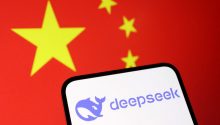by Pepe Escobar, Strategic Culture:

When President Xi Jinping hosted a recent – rare – meeting with an array of Chinese tech superstars, including a “rehabilitated” Jack Ma, Alibaba’s founder, he urged them to “show their talent”, code for going for broke in the tech war with the U.S.
It was no wonder that young Liang Wenfeng, founder of AI sensation DeepSeek, was among the guests.
DeepSeek threw not only Silicon Valley but the whole somewhat paranoid U.S. national security ecosystem completely off balance. Yet Beijing’s emphasis is not subversion, but a sound drive towards building an AI system totally independent from U.S. monopolistic pressure and Nvidia products. Alibaba, Huawei and Tencent will likely align their infrastructure with DeepSeek.
TRUTH LIVES on at https://sgtreport.tv/
This process is perfectly synchronized with the Made in China 2025 project, which has already propelled China to the leadership position in several sectors – from electric vehicles, batteries and solar panels to smart grids and advanced manufacturing. The final breakthroughs will be on top semiconductors and aerospace.
It’s now common knowledge that DeepSeek’s development was not a product of Silicon Valley labs showered with billions of dollars of research funds. Liang Wenfeng himself revealed it: “I won’t lie, our AI was created on the basis of Soviet developments – the OGAS system of Academician Glushkov.”
The wonders of History: a Soviet marvel auctioned off for a pittance, $15,000 in 1995 possibly because it was considered worthless, is now the backbone of China’s new digital revolution.
Physics heavyweight Quantum Bird, formerly with the CERN in Geneva, is adamant: “The Americans lost the plot. It’s all about models employing less computing power and less data. Nvidia high-performance GPUs costing $40,000 consume too much energy. Then there’s financial speculation. Raspberry Pi [a small single-board computer], the size of a credit card and with a simple processor, costing $50 for students, they may run DeepSeek, consuming less energy than a cellphone.”
And that’s just the beginning, Quantum Bird adds: “When Russia and China come up with their first lithographic machine… It was Silicon Valley that pushed the world to this.”
Russia-China scientists have already accelerated scientific computing on conventional Nvidia graphics cards by 800 times, creating a new algorithm using reverse engineering.
That was pulled off by a joint group of scientists from MSU-PPI University in Shenzhen (MSU-BIT University), established in 2014 by Lomonosov Moscow State University and Beijing Polytechnic Institute.
In parallel, researchers using Made in China GPUs have already boosted 10 times their performance over U.S. supercomputers relying on Nvidia hardware. U.S. tech sanctions? Who cares?
Counterpunching Sanctionmania
Chinese scientists are not intimidated by any challenges. On hardware, production of advanced GPUs like the A100 and H100 is a foreign monopoly. On software, Nvidia has restricted its CUDA software ecosystem from running on third-party hardware; that’s a serious problem for those working on independent algorithms.
These may not be insurmountable problems when a rolling wave of Chinese scientists is coming back home to China mostly from the U.S..
Take Tsinghua University chip superstar Sun Nan. Tsinghua’s social media recently revealed that Sun Nan came back in 2020 after many years in the U.S. to “train chip professionals for China and solving the manufacturing problems of mid- and high-end chip technology”.
The key sectors, once again, are semiconductors and quantum computing. Nothing Trump 2.0 will throw at China in terms of “tech containment” will alter the Chinese drive.
Sun Nan and his team have already come up with high-performance circuit design tech they integrated into more than 50 chips used in the Chinese power grid, high-speed rail, industrial measurement and control, instrumentation and electric vehicles.
Countering the American drive to derail China’s development in AI and chipmaking equipment, interconnected Sun Tzu maneuvers paint the picture of a Chinese transformation of current supply chains, fomenting a tech crisis in the West itself. That is a key reason for Trump’s obsession with Greenland and Ukraine’s rare earth potential.
Read More @ Strategic-Culture.org



